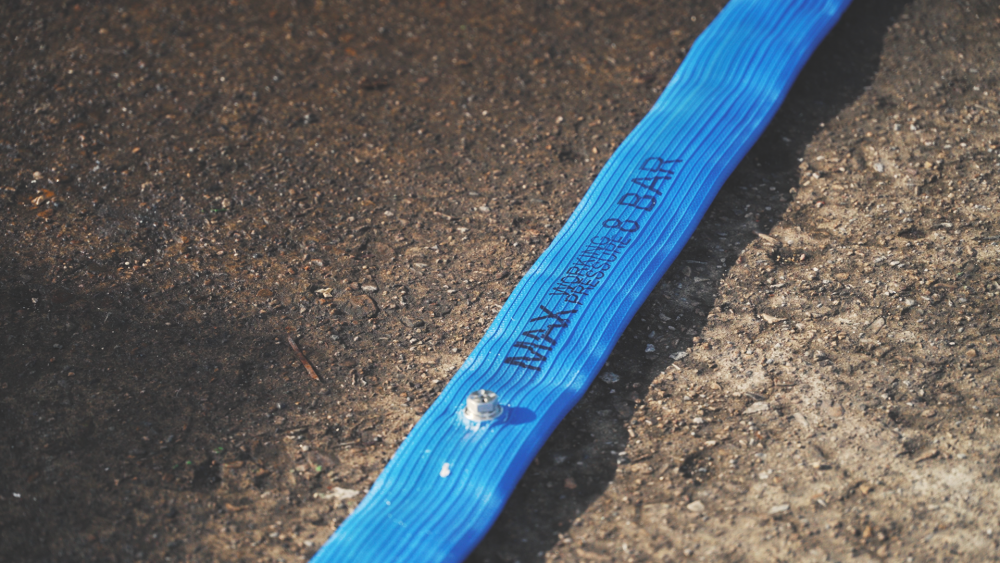Layflat fire hose plays a crucial role in firefighting and industrial operations. Designed for rapid deployment, high water flow, and compact storage, a layflat fire hose is widely used by fire services, oil and gas operators, marine facilities, and industrial sites requiring reliable water or foam delivery.
This guide explains the different types of layflat fire hose, the performance ratings to consider, and how to choose the right product for your application.
Understanding Layflat Fire Hose Construction
Layflat hoses are characterised by their flat shape when unpressurised and their ability to handle significant pressure when charged with water or foam. Typically, they consist of an inner liner, a textile reinforcement layer, and an outer cover. These materials vary depending on the hose’s intended use.
Common construction types include:
- Nitrile Rubber Hose: Durable, abrasion-resistant, and ideal for aggressive environments.
- PU-Lined Polyester Hose: Lightweight and flexible, suitable for rapid deployment and retrieval.
- EPDM Rubber Lining: Offers excellent heat resistance, often used in high-temperature industrial applications.
Delta Fire manufactures layflat hoses using high-quality materials that meet UK and international standards, including BS 6391 and DIN 14811. All hoses are produced in a vertically integrated, ISO-certified facility, supporting consistent quality and rapid lead times.
Types of Layflat Fire Hose
Layflat fire hoses are broadly categorised by usage and operating environment. Below are the key types found across fire and industrial sectors.
Hoses for Municipal Fire Services
Used by UK fire brigades and emergency responders, these hoses require compliance with British Standards and offer balanced performance across flexibility, pressure, and durability.
- Typically rated to 15–20 bar working pressure
- Available in multiple diameters (38mm, 45mm, 64mm)
- Designed for compatibility with UK-standard couplings
Delta Fire hoses are deployed by over 90% of UK Fire & Rescue Services, making them a trusted component of municipal response operations.
Industrial Layflat Hoses
Used in factories, chemical plants, and energy infrastructure, industrial hoses must handle exposure to oils, chemicals, heat, and mechanical wear.
- Higher abrasion and chemical resistance
- Optional anti-static properties for explosive environments
- Larger diameters and higher pressure ratings available
These hoses are particularly relevant to Delta Fire’s “Risk Eliminator” ICPs, including petrochemical and offshore operators who require full system compliance and reliability.
Marine & Offshore Layflat Hoses
Marine environments demand hoses certified for saltwater resistance and compliance with maritime standards.
- Lloyd’s Register and MED approvals
- Saltwater-resistant linings and corrosion-resistant fittings
- Optimised for shipboard storage and deployment
Delta Fire’s marine hose range is designed for durability in harsh offshore environments, contributing to compliant fire suppression systems across defence and marine sectors.
Wildfire & Utility Response Hoses
Layflat hoses for wildland firefighting and utility service use are lightweight, compact, and highly manoeuvrable.
- High heat resistance (e.g. EPDM liners)
- Low weight for rapid deployment
- Designed for hilly or remote environments
Delta’s Hydro-Wall hose is one such example, developed to address wildfire threats and EV battery fires through a water-curtain effect.
Performance Ratings to Consider
Operating Pressure
Most layflat fire hoses are rated by:
- Working Pressure: The standard maximum pressure during regular use (typically 16 bar)
- Burst Pressure: The pressure at which the hose may fail (usually 3x working pressure)
For industrial and marine applications, confirm that the hose’s burst pressure exceeds required safety margins.
Temperature Range
Hoses must remain flexible and safe across wide temperature ranges. EPDM-lined hoses typically operate up to +120°C, while nitrile hoses may perform well in freezing conditions.
Abrasion Resistance
Abrasion levels vary across use cases. Delta Fire’s nitrile rubber hoses are specifically engineered for high-wear applications such as heavy industry or offshore platforms.
Kink Resistance & Flexibility
For rapid deployment and manoeuvrability, flexibility and low kink memory are essential. This is especially critical for fire brigades working in tight urban spaces or complex terrain.
Compliance & Certification
When selecting a hose, look for certifications such as:
- BS 6391 Type 1/2/3
- DIN 14811
- Lloyd’s Register (Marine Use)
- MED (Marine Equipment Directive)
Delta Fire hoses are manufactured under ISO 9001, 14001, and 45001 certifications, supporting quality, environmental, and occupational safety standards.
Choosing the Right Layflat Fire Hose
Selecting the correct layflat fire hose depends on a clear understanding of your operational environment, pressure requirements, and regulatory obligations. Consider the following when evaluating your options:
1. Application Type
- Firefighting (urban/industrial)
- Offshore or marine
- Oil and gas
- Utility or civil defence
2. Required Approvals
Check if your industry or insurer mandates specific standards.
3. Hose Diameter & Coupling Type
Select hose sizes to match pumps, hydrants, and fittings. Delta Fire offers a full range of British and international coupling systems.
4. Storage & Deployment Conditions
If the hose is to be used in confined spaces or rough terrain, prioritise flexibility, lightness, and compact coil dimensions.
5. Foam or Water Delivery?
For foam applications, ensure compatibility with foam agents — particularly fluorine-free foams which are now standard across many sites due to the UK’s upcoming PFAS ban.
Final Thoughts
Choosing the right layflat fire hose is a critical decision in building a resilient firefighting or fire protection system. Whether for municipal firefighting, offshore platforms, or data centre backup systems, the hose must meet stringent operational demands — with no margin for error.
Delta Fire’s UK-manufactured layflat hoses are trusted across sectors for their durability, compliance, and proven performance under pressure. Backed by engineering support and fast delivery, they form a vital link in high-integrity fire suppression systems.
Speak to Our Sales Team
Delta Fire’s specialists can help assess your site requirements and recommend the best Layflat Fire Hose setup for your situation.







